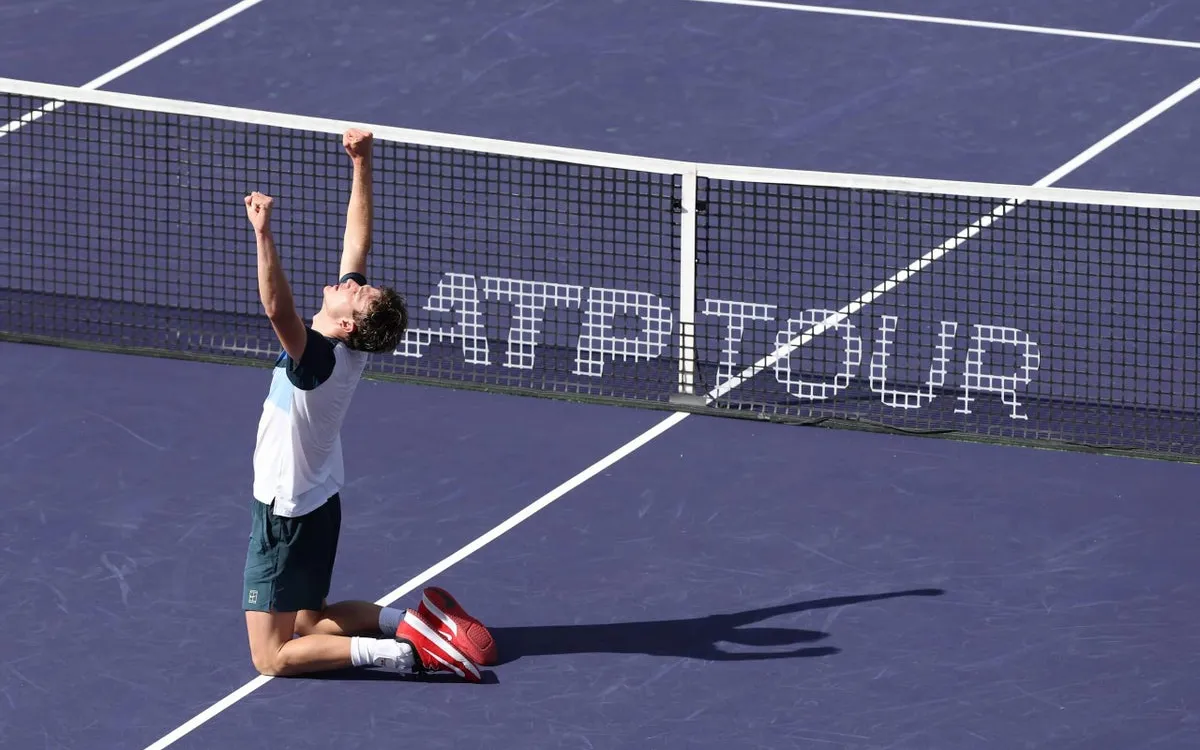
In a stunning display of skill and resilience, Jack Draper triumphed over Holger Rune with a decisive score of 6-2, 6-2 in the men’s singles final at the prestigious Indian Wells tournament on Sunday. As the No. 13 seed, Draper outperformed the No. 12 seed, showcasing an unstoppable serve and capitalizing on Rune’s strategic errors. This victory marks Draper’s first ATP Masters 1,000 title and propels him into the top 10 of the ATP Tour rankings for the first time.
As Draper prepared to serve for the first set, Rune was engaged in a lengthy discussion with his coach, Lars Christensen. Despite their efforts, Rune struggled to make an impact during his return games. Although Rune managed to double his points won in the set, Draper’s serving prowess was overwhelming. He won 16 out of 20 service points in the first set, including seven aces from his 12 first serves. Draper achieved an impressive 90 percent success rate on his first serves throughout the match, further emphasizing his serving dominance.
The second set saw Draper maintain his momentum, winning 18 out of 26 serve points without facing a single break point. His overall success rate for first-serve points stood at an impressive 89 percent. The combination of pace and variety in Draper’s serves left Rune unable to predict his service angles, resulting in a one-sided match that highlighted Draper’s incredible talent.
Coming off a remarkable semifinal victory against Daniil Medvedev, Rune had implemented a strategic shift that proved successful. He spoke about his dual strategy of being aggressive and varying his shot tempo. However, when it came to the final, Rune reverted to his default game plan, which involved taking the ball early and aggressively hunting for forehands.
This time, Draper’s effective play from the front foot disrupted Rune’s approach. Instead of adapting, Rune doubled down on his initial strategy, leading to numerous errors. His shots often landed in the net, and he struggled with directional control, particularly when hitting towards Draper’s forehand. This inability to adjust ultimately cost Rune the match.
Throughout the initial games of the final, Draper seemed to be in a state of flow, but a moment of doubt arose when he faced deuce while serving at 2-1 in the second set. Despite a temporary lapse in concentration, Draper quickly regained his composure, hitting an ace and securing his service game. His ability to manage anxiety, especially in high-stress situations, played a crucial role in his performance.
Draper had previously struggled with anxiety during significant matches, but against Rune, he exhibited remarkable control, serving out the final game to 15. His focus and determination were evident as he approached the biggest title of his career.
Draper's success can also be attributed to wise decisions regarding his health and training. Recognizing the grueling nature of the tennis circuit, he made a commitment to prioritize his well-being, especially concerning a chronic hip issue. Draper intentionally skipped several tournaments to ensure he was fit for Indian Wells, demonstrating a long-term vision for his career.
His strategic scheduling and focus on health paid off, allowing him to perform at his best when it mattered most. Draper’s journey through injury and his commitment to careful planning have set a solid foundation for his future in professional tennis.
After his victory, Draper expressed his gratitude, acknowledging the hard work and sacrifices inherent in the sport. “It’s a real honor to share the court with you today,” he said to Rune. Draper reflected on his previous experience at Indian Wells, where he didn’t advance past the first round last year.
Rune, despite the loss, congratulated Draper and recognized his impressive performance over the two weeks. “What a two weeks you had here. Some incredible tennis and for sure you deserved to win today,” Rune stated, underscoring the mutual respect between the competitors.
This final at Indian Wells not only marks a significant milestone for Jack Draper but also highlights the ongoing evolution of talent in men’s tennis, setting the stage for future encounters between these rising stars.